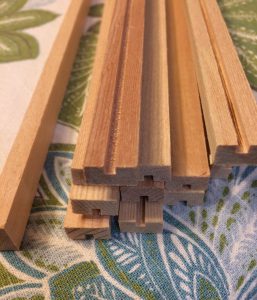Yesterday I tackled the problem of the rib geodetic pieces. The thinnest I could order from anywhere was 1/8″, and the plans call for 3/32″ thick. What I got from ACS was actually a bit oversized at .130 to .140. So, I need to shave about .040 to ..045 or so off of 120 or so 6′ long strips of spruce.
I tried a small razor plane… no joy there. Maybe it was my technique, but the blade dug in and left a very rough, uneven surface. It’s quite possible I could make this work with a “real” hand plane, but I’d have to go buy one, then learn to use it properly, and let’s be honest — right now I’m a little impatient to start building. I tried spinning up an end mill in the CNC machine, but it was obviously over-taxed and would take several passes. Probably the wrong tool for the job. Maybe a router bit would have been better, but there was also a work space issue, and the small motor and flex shaft drive was not going to be up to the task. I knew I was fighting a losing battle there. My Harbor Freight belt/disk sander seemed promising, but the top roller on the belt is convex and was leaving a concave surface. I was not too confident in trying to use the table saw to shave them down, given how quickly things can go wrong there.
I ended up buying an oscillating spindle sander at Menard’s. With a guide board clamped to the table, it lets me feed the strips in and sand them down to a nice consistent .093″ thickness. It’s really slow going to try to do it all in one pass, so I set up a second guide board on the other side to knock them down about half way. One pass on one side, then a second pass on the other side of the drum and I have what I need. It still takes quite a bit of time. I installed the second largest drum, 2″ in diameter, but I think I’ll re-set it up with the larger 3″ drum instead. The higher speed of the drum surface may help to make it go a little faster, and the larger surface area might keep the drum from loading up or wearing out longer. With the shop vacuum sucking dust out around the spindle there’s virtually no sanding dust floating around, so that’s nice.
I got four strips done before I knocked off for the day. Doesn’t sound like much, but there was also a few hours of Pinewood Derby axle and wheel work in there, as well as some play time with the grandkids. Oh, and I did groove a couple dozen more rib capstrips too.


